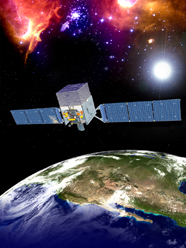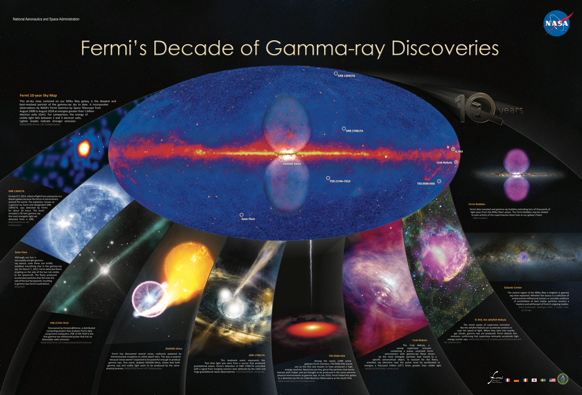Important Announcements
What is Fermi?
 The Universe is home to numerous exotic and beautiful phenomena, some of which can generate almost inconceivable amounts of energy. Supermassive black holes, merging neutron stars, streams of hot gas moving close to the speed of light ... these are but a few of the marvels that generate gamma-ray radiation, the most energetic form of radiation, billions of times more energetic than the type of light visible to our eyes. What is happening to produce this much energy? What happens to the surrounding environment near these phenomena? How will studying these energetic objects add to our understanding of the very nature of the Universe and how it behaves?
The Universe is home to numerous exotic and beautiful phenomena, some of which can generate almost inconceivable amounts of energy. Supermassive black holes, merging neutron stars, streams of hot gas moving close to the speed of light ... these are but a few of the marvels that generate gamma-ray radiation, the most energetic form of radiation, billions of times more energetic than the type of light visible to our eyes. What is happening to produce this much energy? What happens to the surrounding environment near these phenomena? How will studying these energetic objects add to our understanding of the very nature of the Universe and how it behaves?
The Fermi Gamma-ray Space Telescope, formerly GLAST, is opening this high-energy world to exploration and helping us answer these questions. With Fermi, astronomers at long last have a superior tool to study how black holes, notorious for pulling matter in, can accelerate jets of gas outward at fantastic speeds. Physicists are able to study subatomic particles at energies far greater than those seen in ground-based particle accelerators. And cosmologists are gaining valuable information about the birth and early evolution of the Universe.
For this unique endeavor, one that brings together the astrophysics and particle physics communities, NASA has teamed up with the U.S. Department of Energy and institutions in France, Germany, Japan, Italy and Sweden. General Dynamics was chosen to build the spacecraft. Fermi was launched June 11, 2008 at 12:05 pm EDT.
Latest News
Apr 21, 2025
Fermitools 2.4.0 Released
An updated version (2.4.0) of the Fermitools is now available. Improvements focus on resolving issues with outdated dependencies and improving compatibility (e.g., Astropy). This release also includes a range of bug fixes, enhancements to backend code, and updates to the build system.
+ Release Notes
Feb 6, 2025
Cycle 18 Solicitation Amended
The Fermi Cycle 18 solicitation was amended on February 5 to clarify that the page limit for the Science/Technical/Management section of Phase-1 proposals is four pages for Regular proposals and six pages for Large proposals. These page limits include figures but not references. This is a change from Cycle 17 when the 4- and 6-page limits included references. As a reminder, the solicitation was amended on January 17 to change the proposal due date to March 5, 2025. Full details of the Fermi Cycle 18 solicitation can be found in Roses Appendix D.6
Jan 22, 2025
Fermi Phase 1 Deadline Now 5 Mar 2025
The Phase 1 deadline for the Fermi GI program has been deferred to 5 March 2025. Please see the Cycle-18 call for proposals (ROSES D.6) for details and contact the Fermi Helpdesk with any questions (fermihelp@milkyway.gsfc.nasa.gov).



